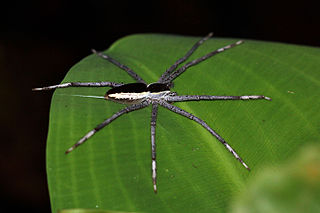
Nursery web spiders (Pisauridae) are a family of araneomorph spiders first described by Eugène Simon in 1890. Females of the family are known for building special nursery webs. When their eggs are about to hatch, a female spider builds a tent-like web, places her egg sac inside, and stands guard outside, hence the family's common name. Like wolf spiders, however, nursery web spiders are roaming hunters that don't use webs for catching prey.

Gasteracantha is a genus of orb-weaver spiders first named by Carl Jakob Sundevall in 1833. Species of the genus are known as spiny-backed orb-weavers, spiny orb-weavers, or spiny spiders. The females of most species are brightly colored with six prominent spines on their broad, hardened, shell-like abdomens. The name Gasteracantha is derived from the Greek gaster (γαστήρ), meaning "belly, abdomen", and akantha (άκανθα), meaning "thorn, spine". Spiny-backed orb-weavers are sometimes colloquially called "crab spiders" because of their shape, but they are not closely related to the true crab spiders. Other colloquial names for certain species include thorn spider, star spider, kite spider, or jewel spider.

Idiopidae, also known as armored or spiny trapdoor spiders, is a family of mygalomorph spiders first described by Eugène Simon in 1889.

Barychelidae, also known as brushed trapdoor spiders, is a spider family with about 300 species in 39 genera.

Stegodyphus is a genus of velvet spiders that was first described by Eugène Simon in 1873. They are distributed from Africa to Europe and Asia, with one species found in Brazil. The name is derived from Ancient Greek στέγω, meaning "covered".

Poecilotheria is a genus of tarantulas native to India and Sri Lanka. It was first described by Eugène Louis Simon in 1885. They are arboreal tarantulas, commonly known as ornamental tarantulas, known for their vivid color patterns, fast movement, and potent venom compared to other tarantulas. As of 2019 all species are protected under CITES.

Tarantulas comprise a group of large and often hairy spiders of the family Theraphosidae. As of December 2023, 1,100 species have been identified, with 166 genera. The term "tarantula" is usually used to describe members of the family Theraphosidae, although many other members of the same infraorder (Mygalomorphae) are commonly referred to as "tarantulas" or "false tarantulas". Some of the more common species have become popular in the exotic pet trade. Many New World species kept as pets have setae known as urticating hairs that can cause irritation to the skin, and in extreme cases, cause damage to the eyes.

Idiops is a genus of armored trapdoor spiders that was first described by Josef Anton Maximilian Perty in 1833. It is the type genus of the spurred trapdoor spiders, Idiopidae. Idiops is also the most species-rich genus of the family, and is found at widely separated locations in the Neotropics, Afrotropics, Indomalaya and the Middle East. Females live in tubular burrows lined with a thick layer of white silk. These typically have a D-shaped lid that fits into the entrance like a cork, and some burrows have two entrances. The lid may consist of mud, moss or lichen, which is bound below by a thick layer of silk. As in all genera of this family, the anterior lateral eyes (ALE) are situated near the clypeal margin, far in front of the remaining six eyes, which are arranged in a tight group. The males which are smaller in size, wander about or occasionally live in burrows. Like other mygalomorphs, they are relatively large and long-lived. Forest clearance and agricultural practices that loosen the soil and enhance erosion, besides soil removal for brick making have been pointed out as serious threats to some Indian species. Species ranges are poorly known – in India for instance, most species are known only from their type localities.
Scalidognathus is a genus of Asian armored trapdoor spiders that was first described by Ferdinand Anton Franz Karsch in 1892. Originally placed with the Ctenizidae, it was moved to the Idiopidae in 1985.
Titanidiops is a genus of armored trapdoor spiders that was first described by Eugène Louis Simon in 1903. As of April 2022 it contains 9 species.

Olios is the largest genus of huntsman spiders, containing 166 species. They are found throughout the world, with most species occurring in hot countries. The genus was first described by Charles Athanase Walckenaer in 1837.

Cyrtarachne is a genus of orb-weaver spiders first described by Tamerlan Thorell in 1868.
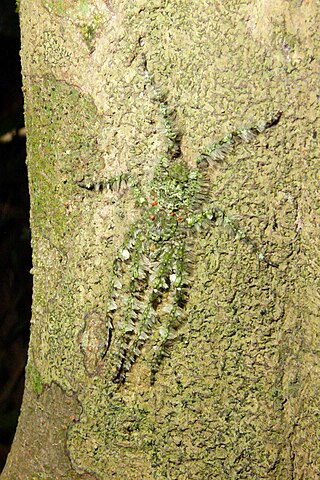
Pandercetes is a genus of huntsman spiders that was first described by Ludwig Carl Christian Koch in his 1875 treatise on Australian spiders. They are mainly distributed in tropical Asia and Australia, and are known for their cryptic coloration that matches local moss and lichen. Their legs have lateral hairs, giving them a feathery appearance, further masking their outline against tree trunks. Their head is somewhat elevated and the carapace has the thoracic region low and flat.
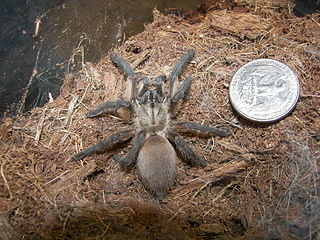
The Eumenophorinae are a subfamily of tarantula spiders. They are known from genera distributed across Sub-Saharan Africa, the south of the Arabian peninsula, Madagascar and its associated islands, and parts of India.

Chilobrachys is a genus of Asian tarantulas that was first described by Ferdinand Anton Franz Karsch in 1892. They are found in India, Myanmar, Malaysia, China, Vietnam, Thailand and Sri Lanka. They are usually medium or large-sized, and they can stridulate by using small spines present on the chelicerae.
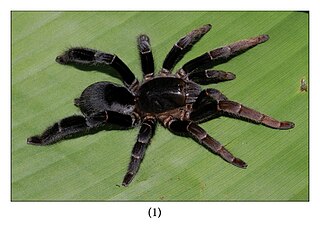
Lyrognathus is a genus of Asian tarantulas that was first described by Reginald Innes Pocock in 1895.
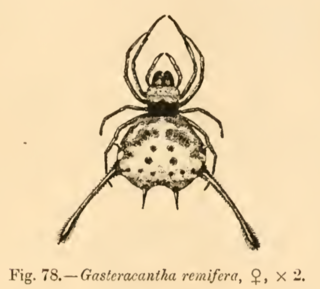
Gasteracantha remifera is a species of spiny orb-weaver spider in the genus Gasteracantha. It is found in Sri Lanka and India, and it has a pair of long, club-shaped spines on its abdomen.
Plesiophrictus is a genus of tarantulas that was first described by Reginald Innes Pocock in 1899.
Sasonichus is a monotypic genus of Asian brushed trapdoor spiders containing the single species, Sasonichus sullivani. It was first described by Reginald Innes Pocock in 1900, and has only been found in India. The species Sipalolasma arthrapophysis was briefly placed here before being moved to Sipalolasma in 1985.
Heterophrictus is a genus of Indian tarantulas that was first described by Reginald Innes Pocock in 1900.













